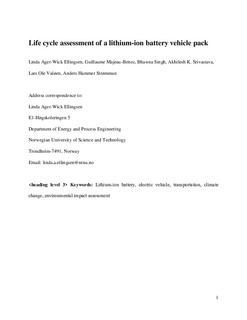| dc.contributor.author | Ellingsen, Linda Ager-Wick | |
| dc.contributor.author | Majeau-Bettez, Guillaume | |
| dc.contributor.author | Singh, Bhawna | |
| dc.contributor.author | Srivastava, Akhilesh Kumar | |
| dc.contributor.author | Valøen, Lars Ole | |
| dc.contributor.author | Strømman, Anders Hammer | |
| dc.date.accessioned | 2017-11-17T10:19:52Z | |
| dc.date.available | 2017-11-17T10:19:52Z | |
| dc.date.created | 2013-11-15T11:06:44Z | |
| dc.date.issued | 2014 | |
| dc.identifier.citation | Journal of Industrial Ecology. 2014, 18 (1), 113-124. | nb_NO |
| dc.identifier.issn | 1088-1980 | |
| dc.identifier.uri | http://hdl.handle.net/11250/2466860 | |
| dc.description.abstract | Electric vehicles have no tailpipe emissions, but the production of their batteries leads to environmental burdens. In order to avoid problem-shifting, a life cycle perspective should be applied in the environmental assessment of traction batteries. The goal of this study is to provide a transparent inventory for a lithium-ion nickel-cobalt-manganese traction battery based on primary data and to report its cradle-to-gate impacts. The study was carried out as a process-based attributional life cycle assessment. The environmental impacts were analyzed using midpoint indicators. The global warming potential of the 26.6 kilowatt-hour (kWh), 253 kg battery pack was found to be 4.6 tonnes carbon dioxide equivalents. Regardless of impact category, the production impacts of the battery are caused mainly by the production chains of battery cell manufacture, the positive electrode paste, and the negative current collector. The robustness of the study was tested through sensitivity analysis, and results were compared with preceding studies. Sensitivity analysis indicates that the most effective approach to reduce climate change emissions would be to produce the battery cells with electricity from a cleaner energy mix. On a per-kWh basis, cradle-to-gate greenhouse gas emissions of the battery are within the range of those reported in preceding studies. Contribution and structural path analysis allowed for identification of the most impact-intensive processes and value chains. This article provides an inventory based mainly on primary data, which can easily be adapted to subsequent EV studies, and offers improved understanding of environmental burdens pertaining to lithium ion traction batteries. | nb_NO |
| dc.language.iso | eng | nb_NO |
| dc.publisher | Wiley | nb_NO |
| dc.title | Life Cycle Assessment of a Lithium-Ion Battery Vehicle Pack | nb_NO |
| dc.type | Journal article | nb_NO |
| dc.type | Peer reviewed | nb_NO |
| dc.description.version | acceptedVersion | nb_NO |
| dc.source.pagenumber | 113-124 | nb_NO |
| dc.source.volume | 18 | nb_NO |
| dc.source.journal | Journal of Industrial Ecology | nb_NO |
| dc.source.issue | 1 | nb_NO |
| dc.identifier.doi | 10.1111/jiec.12072 | |
| dc.identifier.cristin | 1065873 | |
| dc.relation.project | Norges teknisk-naturvitenskapelige universitet: 209697 | nb_NO |
| dc.description.localcode | © 2013 by Yale University. This is the authors' accepted and refereed manuscript to the article. | nb_NO |
| cristin.unitcode | 194,64,25,0 | |
| cristin.unitname | Institutt for energi- og prosessteknikk | |
| cristin.ispublished | true | |
| cristin.fulltext | postprint | |
| cristin.qualitycode | 2 | |
